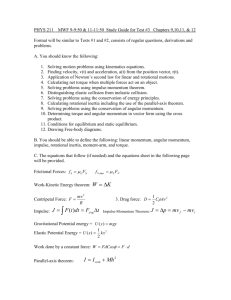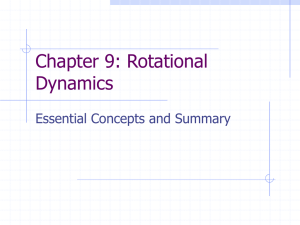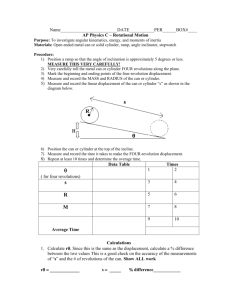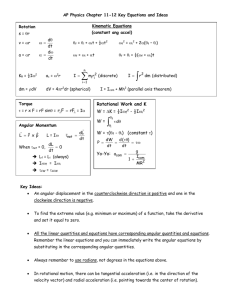Chapter 10 Dynamics of Rotational Motion
advertisement
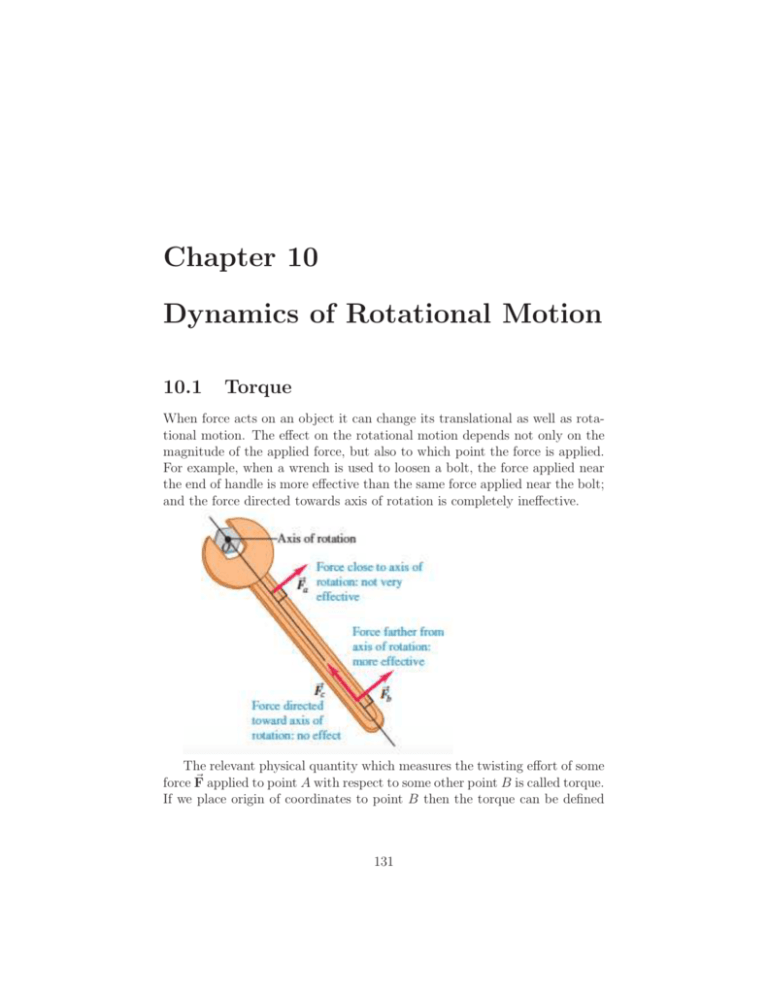
Chapter 10 Dynamics of Rotational Motion 10.1 Torque When force acts on an object it can change its translational as well as rotational motion. The effect on the rotational motion depends not only on the magnitude of the applied force, but also to which point the force is applied. For example, when a wrench is used to loosen a bolt, the force applied near the end of handle is more effective than the same force applied near the bolt; and the force directed towards axis of rotation is completely ineffective. The relevant physical quantity which measures the twisting effort of some ⃗ applied to point A with respect to some other point B is called torque. force F If we place origin of coordinates to point B then the torque can be defined 131 CHAPTER 10. DYNAMICS OF ROTATIONAL MOTION as where ⃗ ⃗τ ≡ ⃗r × F. 132 (10.1) ⃗ − force applied to object at point B F ⃗r − position of B measured with origin at A. ⃗ and ⃗r lie in the plane orthogonal to the axis It is assume that both vectors F of rotation, then torque would point along the axis of rotation determined by right-hand rule. It is a convention to use right hand coordinate system and so the torque is positive if the force causes counterclockwise rotation and negative if the force cause clockwise rotation. Moreover the magnitude of torque is τ = rF sin θ. (10.2) CHAPTER 10. DYNAMICS OF ROTATIONAL MOTION 133 which suggests two possible interpretations. First of all if we define lever-arm as distance between line of action of force, i.e. l ≡ r sin θ (10.3) ⃗ and ⃗r then the torque is product of where θ is the angle between vectors F force and lever-arm τ = F l. (10.4) Secondly if we define tangential component of the force as F|| ≡ F sin θ (10.5) then torque is product of tangential force to radius of rotation τ = F|| r. (10.6) Example 10.1. To loosen a pipe fitting, a weekend plumber slips a piece of scrap pipe (a “cheater”) over his wrench handle. He stands on the end of the cheater, applying his full 900 N weight at a point 0.80 m from the center of the fitting. the wrench and cheater make an angle of 19◦ with horizontal. Find the magnitude and direction of the torque he applies about the center of the fitting. The lever-arm is l = r sin θ = (0.80 m) sin(109◦) = 0.76 m (10.7) and the magnitude of torque is τ = F l = (900 N) (0.76 m) = 680 N·m. (10.8) Similarly, tangent force is F|| = F sin θ = (900 N) sin(109◦ ) = 680 N·m (10.9) CHAPTER 10. DYNAMICS OF ROTATIONAL MOTION 134 and the magnitude of torque is τ = F|| r = (680 N·m) (0.80 m) . (10.10) The direction is determine by right-hand rule and thus points out of the paper (or positive z direction since the rotation is counterclockwise). 10.2 Torque and Angular Acceleration for a Rigid Body Consider a single point-like particle in a rigid body whose displacement from the axis of rotation is r1 , mass is m1 and total force acting on it is F1 . Since the only component of the force which contributes to rotation is parallel (or tangential), the second law for this force reads as F1,|| = m1 a1,|| . (10.11) But since the parallel acceleration is a1,|| = r1 αz (10.12) τ1,z = F1,|| r1 (10.13) τ1,z = m1 r12 αz . (10.14) and torque is we get The same applies to every point-like particle in a rigid body and so the total torque is ! ! τi,z = mi ri2 αz i ! i τi,z = Iαz . (10.15) i Here we include all forces including internal forces of nearby particles, but since (according to third law) such forces produces the same in magnitude and opposite in direction torques their overall effect is zero. Therefore the above equation can be rewritten as ! τI,z = Iαz (10.16) I CHAPTER 10. DYNAMICS OF ROTATIONAL MOTION 135 where the sum on the left hand side is over all torques due to only external forces. Example 10.2. (setup as in Example 9.7) We wrap a light, nonstretching cable around a solid cylinder of mass 50 kg and diameter 0.120 m, which rotates in frictionless bearings about a stationary horizontal axis. We pull the free end of the cable with a constant 9.0 − N force for a distance of 2.0 m; it turns the cylinder as it unwinds without slipping. The cylinder is initially at rest. What is the cable’s acceleration? The total torque is τ = FR (10.17) 1 I = MR2 2 (10.18) and the moment of inertia is where F = 9.0 N R = 0.060 m M = 50 kg. Then (according to Eq. (10.16)) the angular acceleration is τ α = I FR = 1 MR2 2 F = 2 MR = 6.0 rad/s2 (10.19) (10.20) and linear acceleration is a|| = αR F = 2 M = 0.36 m/s2 . (10.21) CHAPTER 10. DYNAMICS OF ROTATIONAL MOTION 136 Example 10.3. (setup as in Example 9.8) We wrap a light, non-stretching cable around a solid cylinder with mass M and radius R. The cylinder rotates with negligible friction about a stationary horizontal axis. We tie the free and of the cable to a block of mass m and release the block from rest at distance h above the floor. As the block falls, the cable unwinds without stretching or slipping. What are the acceleration of falling block and the tension in the cable? For the block the (translational) second law along the vertical direction gives us us mg − T = may (10.22) and for the cylinder the (rotational) second law gives us where T R = Iαz (10.23) 1 I = MR2 2 (10.24) 2T . MR (10.25) and thus αz = 137 CHAPTER 10. DYNAMICS OF ROTATIONAL MOTION Moreover the angular and linear accelerations are related ay R (10.26) 2T M (10.27) αz = By equating (10.25) and (10.26) we get ay = which can be substituted into (10.22) mg − T = m and solved for tension T = 2T M mg . 1 + 2m M (10.28) (10.29) This can also be plugged back to (10.27) to get the (linear) acceleration ay = 10.3 2mg 2 mg . 2m = M 1+ M M + 2m (10.30) Rigid-body Rotation About a Moving Axis More generally a given rigid body can have both rotational motion (about some axis passing through center of mass) and translation motion (of the center of mass). In this case the total kinetic energy is a sum of rotational and translational kinetic energies, i.e. 1 1 2 K = Mvcm + Icm ω 2 . 2 2 (10.31) This can be shown by imagining the rigid body made up of many particles with masses mi moving with velocities ⃗vi so that the total kinetic energy is K= 1! mi (⃗vi · ⃗vi ) . 2 i (10.32) If we now define a relative velocity of each particle with respect to center of mass as ⃗vi′ = ⃗vi − ⃗vcm (10.33) 138 CHAPTER 10. DYNAMICS OF ROTATIONAL MOTION then 1! mi (⃗vi · ⃗vi ) 2 i " ## 1! " ′ = mi (⃗vi + ⃗vcm ) · v⃗′ i + ⃗vcm 2 i ! 1! = mi (⃗vcm · ⃗vcm ) + ⃗vcm · mi ⃗vi′ + 2 i $ % $ i % ! ! 1 2 mi vcm + ⃗vcm · mi ⃗vi′ + = 2 i i K = 1! mi (⃗vi′ · ⃗vi′ ) 2 i 1! mi v ′2 i 2 i (10.34) where $ % 1 ! 2 mi vcm = 12 Mvcm - translational kinetic energy of the center of mass 2 i $ % ' & ! ! ( i mi ⃗v′ i ) ′ ⃗vcm · − zero since velocity of cm with respect to cm is zero mi ⃗vi ∝ ⃗vcm · M i 1! mi vi′2 2 i = 21 Icm ω 2 −rotational kinetic energy around center of mass. An important example of the combined rotational and translational motion is rolling without slipping. CHAPTER 10. DYNAMICS OF ROTATIONAL MOTION 139 Then the center of mass velocity is related to angular velocity vcm = Rω (10.35) and one can think of the motion in two alternative ways: as purely rotational motion about point 1, or as combination of rotational motion around point 0 and translational motion of 0. To see that two views give the same kinetic energy we can use the parallel-axis theorem that we derived in the previous chapter, i.e. 1 I1 ω 2 2 ) 1( = Icm + MR2 ω 2 2 1 1 Icm ω 2 + MR2 ω 2 = 2 2 1 1 2 = Icm ω 2 + Mvcm . 2 2 K = (10.36) If in addition the potential energy changes (as in the case of gravitational potential energy), then the total mechanical energy is given by 1 1 2 + Icm ω 2 + Mgycm K = Mvcm 2 2 (10.37) and thus one might think of potential energy coming from a point particle with mass M located at the body’s center of mass. Example 10.4. You make a primitive yo-yo by wrapping a massless string around a solid cylinder with mass M and radius R. You hold the free end of the string stationary and release the cylinder from rest. The string unwinds but does not slip or stretches the cylinder descends and rotates. Using energy considerations, find the speed of the center of mass of the cylinder after it has descended a distance h. CHAPTER 10. DYNAMICS OF ROTATIONAL MOTION 140 If the set the zero of potential energy at the initial position of the yo-yo, then from conservation of total mechanical energy 1 Mgyf + Mvf2 + 2 1 Mgyf + Mvf2 + 2 1 2 1 1 Iωf = Mgyi + Mvi2 + Iωi2 2 2 2 1 2 Iω = 0. 2 f (10.38) where yf = −h vf ωf = R 1 I = MR2 . 2 (10.39) By combining (10.38) and (10.39) we get & '" # 1 1 1 vf 2 2 2 −Mgh + Mvf + MR = 0 2 2 2 R 1 2 1 2 v + v = gh 2 f 4 f * vf = 4gh . 3 Dynamics. In a special case when the axis of rotation • is the axis of symmetry and • does not change direction, (10.40) CHAPTER 10. DYNAMICS OF ROTATIONAL MOTION 141 the combined rotational and translational dynamics can be described in context of second law, i.e. ! ⃗ I = M⃗acm F I ! τzI = Icm αz (10.41) I where the sum in both equations goes only external quantities (i.e. forces and torques). Example 10.6. You make a primitive yo-yo by wrapping a massless string around a solid cylinder with mass M and radius R. You hold the free end of the string stationary and release the cylinder from rest. The string unwinds but does not slip or stretches the cylinder descends and rotates. Find downward acceleration of the cylinder and the tension in the string. For the (rotational and translational) second laws we get Mg −T = Macm & ' 1 2 TR = MR αz 2 (10.42) and moreover from (10.35) we get vcm = Rω (10.43) acm = Rαz (10.44) or after differentiating both sides CHAPTER 10. DYNAMICS OF ROTATIONAL MOTION 142 and substituting into equations (10.42) we get two equations Mg −T = Macm & ' 1 T = M acm 2 (10.45) with two unknowns acm and T which leads to following solutions 2 g 3 1 g. T = 3 acm = 10.4 (10.46) Work and Power in Rotational Motion Similarly to how translational work is given by an integral + xf W = Fx (x)dx (10.47) xi the rotational work is given by W = W = W = + + + F|| ds. F|| Rdθ. θf τz (θ)dθ (10.48) θi In the case of force independent of angle we have W = τz (θf − θi ) = τz ∆θ. (10.49) Moreover, the power associated with rotational work can be expressed as P = dW dθ = τz = τz ωz . dt dt (10.50) The integral of (10.48) can also be rewritten by applying the (rotational) CHAPTER 10. DYNAMICS OF ROTATIONAL MOTION 143 second law, W = = = = = + θf θi + θf τz (θ)dθ Iαz dθ θi + θf I +ωωi f Iωz dωz +θiωf dωz dθ dt dθ I dωz dt ωi 1 2 1 2 Iω − Iω (10.51) 2 f 2 i i.e expressing work as a change of rotational kinetic energy. Example 10.8. An electric motor exerts a constant τ = 10 − N · m torque on grindstone which has moment of inertia of I = 2.0 kg·m2 about its shaft. The system starts from rest. Find the work W done by the motor in t = 8.0 s and the grindstone kinetic energy K at this time. What average power Pav is delivered by the motor? Since the motor exerts a constant torque the (rotational) second law implies τ = Iαz (10.52) = or αz = τ I (10.53) and after time t the angular velocity is ω = αz t = τt I (10.54) Therefore the work done by the motor is W = Kf − Ki 1 2 = Iω 2 & '2 τt 1 I = 2 I 2 2 τ t = 2I (10 N·m)2 (8.0 s)2 ( ) = 1600 J = 2 · 2.0 kg·m2 (10.55) 144 CHAPTER 10. DYNAMICS OF ROTATIONAL MOTION and average power W t τ 2t = 2I (10 N·m)2 (8.0 s) ( ) = 200 W. = 2 · 2.0 kg·m2 Pav = 10.5 (10.56) Angular Momentum A rotation analog of linear momentum is angular momentum defined as ⃗ ≡ ⃗r × ⃗p = ⃗r × (m⃗v) . L (10.57) Then the rate of change change of angular momentum & ' ⃗ dL d⃗r d⃗v = × (m⃗v) + ⃗r × m dt dt dt = ⃗r × (m⃗a) ⃗ = ⃗r × F = ⃗τ is nothing but torque of the net force acting on a particle. (10.58) CHAPTER 10. DYNAMICS OF ROTATIONAL MOTION 145 For a rigid body the same is true for every particle and if we choose the axis of rotation to point along z axis, then the total angular momentum is ! Lz = Lzi i = ! ri (mi vi ) i = ! ri (mi ri ωz ) i = Iωz . (10.59) If the axis of rotation is also a symmetry axis, then all other components of angular momentum vanish and thus we can write ⃗ = I⃗ω . L (10.60) If we apply (10.58) to every particle in a rigid body, then the rate of change of the angular momentum of a rigid body is given by ! ⃗ dL ⃗τI = dt I CHAPTER 10. DYNAMICS OF ROTATIONAL MOTION 146 where the sum on the left-hand-side is over all torques due to external forces, since the torques due to all internal (i.e. action-reaction pairs) cancel. Moreover if the rigid body rotates around a symmetry axis (which without loss of generality we can choose to point along z axis) then ! τz = Iαz . Example 10.9. A turbine fan in a jet engine has a moment of inertia of I = 2.5 kg·m2 about its axis of rotation. As the turbine starts up, its angular velocity is given by ( ) ωz = 40 rad/s3 t2. (a) Find the fan’s angular momentum as a function of time and find its value at t = 3.0s. (b) Find the net torque on the fan as a function of time, and find its value at t = 3.0 s. The turbine’s angular momentum is and thus at t = 3.0s, Lz = Iωz )( ) ( = 2.5 kg·m2 40 rad/s3 t2 ( ) = 100 kg·m2 /s3 t2 The net torque is ( ) Lz = 100 kg·m2 /s3 t2 = 900 kg·m2 /s. thus at t = 3.0s, τz = Iαz dωz = I ( dt )( ) = 2.5 kg·m2 80 rad/s3 t ( ) = 200 kg·m2 /s3 t ( ) τz = 200 kg·m2 /s3 (3.0s) = 600 N·m. CHAPTER 10. DYNAMICS OF ROTATIONAL MOTION 10.6 147 Conservation of Angular Momentum When the net external torque acting on a system is zero, the total angular momentum of the system is constant. ⃗i L⃗f = L This does not mean that the change of angular momentum of part of a given body must not changes. Example 10.10. A physics professor stands at the center of a frictionless turntable with arms outstretches and a m = 5.0 − kg dumbbell in each hand. He is set rotating about the vertical axis, making one revolution in T = 2.0 s. Find his final angular velocity is he pulls the dumbbells in to his stomach. His moment of inertia (without the dumbbells) is Ii = 3.0 kg·m2 with arms outstretched and If = 2.2 kg · m2 with his hands at his stomach. The dumbbells are ri = 1.0 m from the axis initially and rf = 0.20 m at the end. To total angular momentum is conserved, i.e. Ii ωi + 2mri2 ωi = If ωf + 2mrf2 ωf where ωi = 1 rev = 0.50 rev/s T CHAPTER 10. DYNAMICS OF ROTATIONAL MOTION and thus ωf = ωi Ii + 2mri2 If + 2mrf2 = (0.50 rev/s) 3.0 kg·m2 + 2 (5.0 kg) (1.0 m)2 = 2.5 rev/s. 2.2 kg·m2 + 2 (5.0 kg) (0.20 m)2 148


